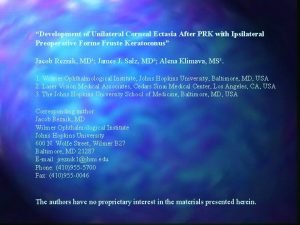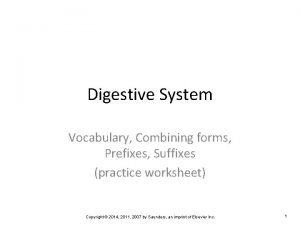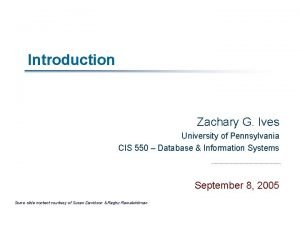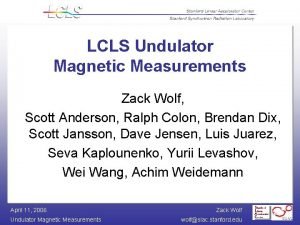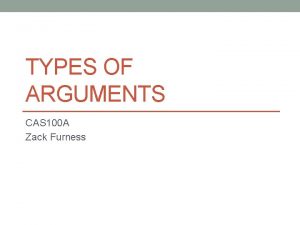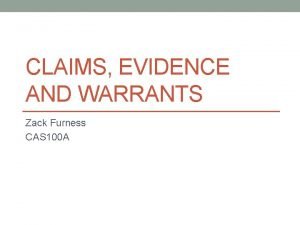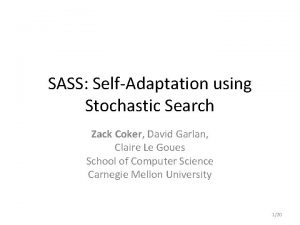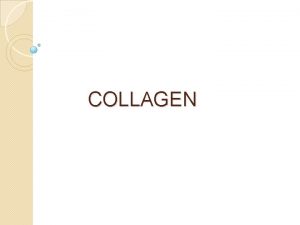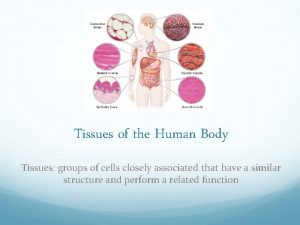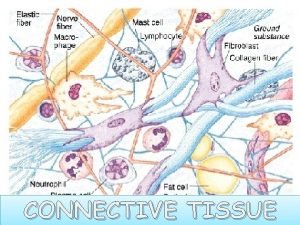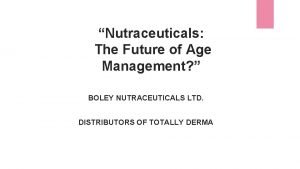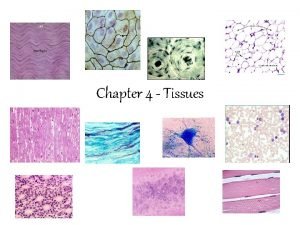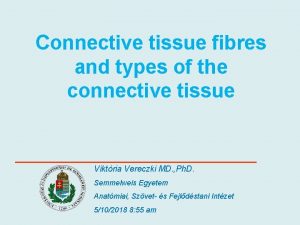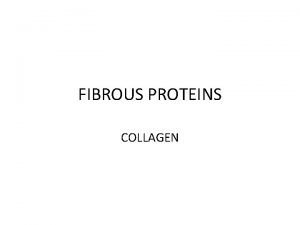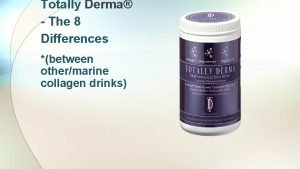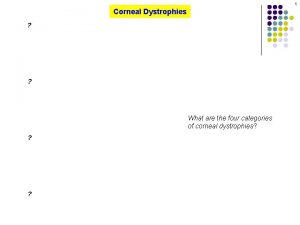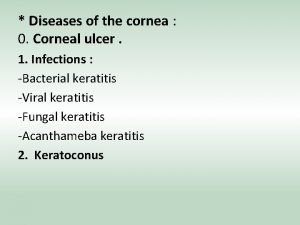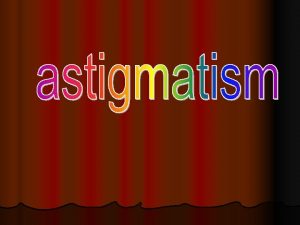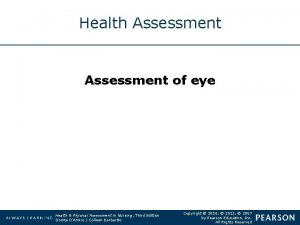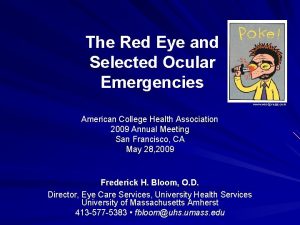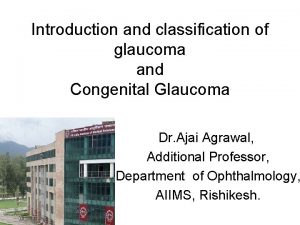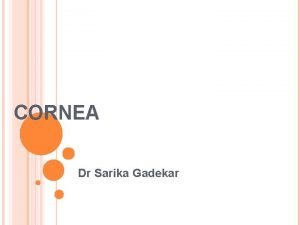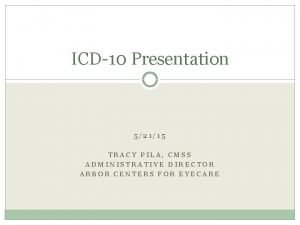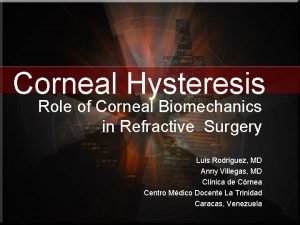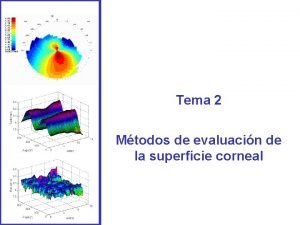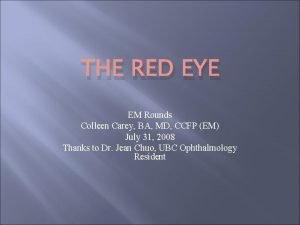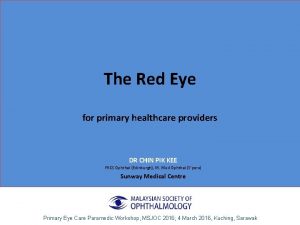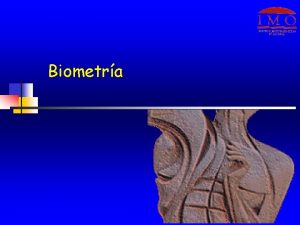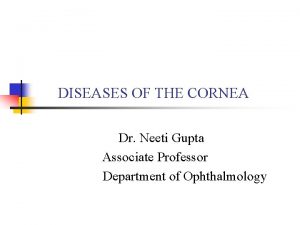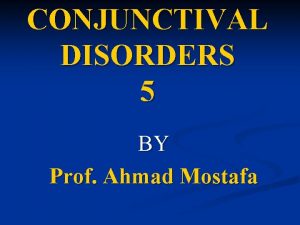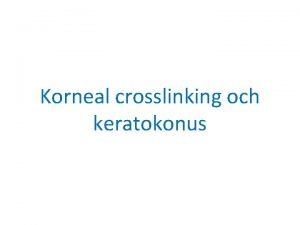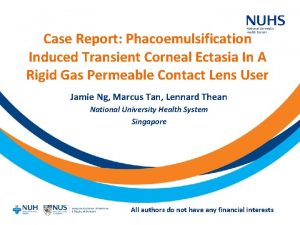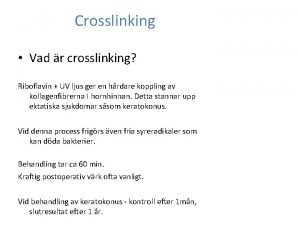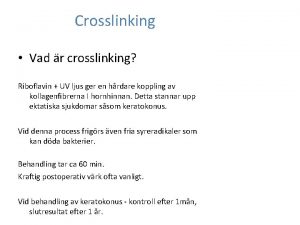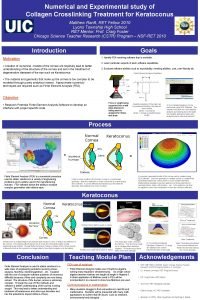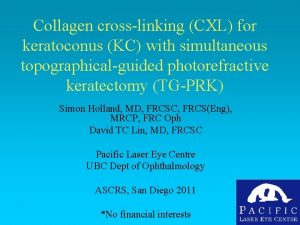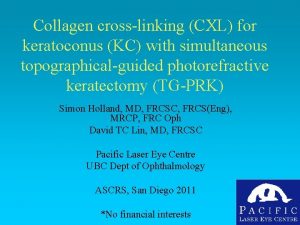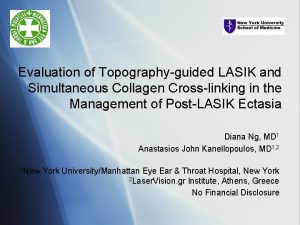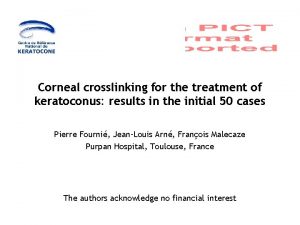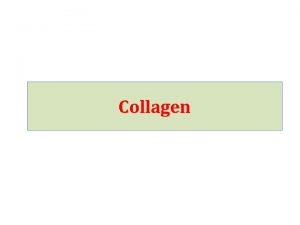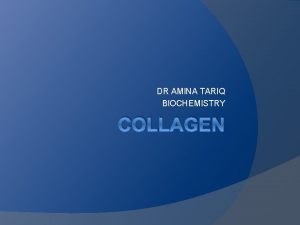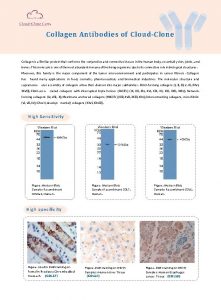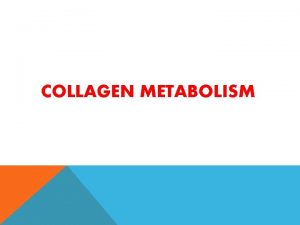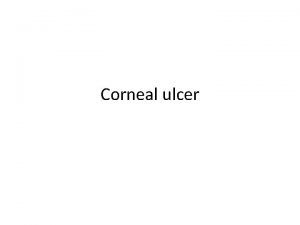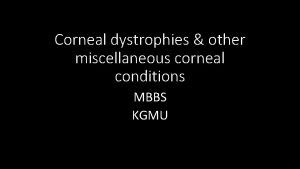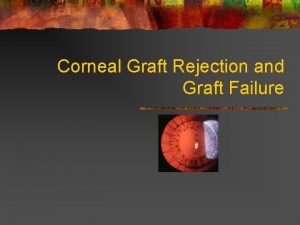Collagen Crosslinking for Corneal Ectasia Zack Zavodni MD














































- Slides: 46

Collagen Crosslinking for Corneal Ectasia Zack Zavodni, MD February 2018 The Eye Institute of Utah University of Utah John A. Moran Eye Center

No financial interests


Outline Who and When to refer for crosslinking How to counsel potential crosslinking patients How does crosslinking work How to care for the post-operative patient Future directions for crosslinking

Who and When to refer for CXL Corneal ectasia Keratoconus, PMD Post-LASIK Markers of progression Manifest refraction, BCVA Topography Tomography OCT/epithelial thickness Extent/stage of disease Age

Case 1 44 year old male with KCN No subjective change in vision Old glasses from 2012: -6. 00 + 6. 00 x 7 (20/30) 2017: -6. 75 +5. 25 x 165 (20/25)


Management Options Refer for CXL Refer for PKP Recommend repeat exam and scans in 3 months Recommend repeat exam and scans in 12 months

Case 2 16 year old with rapidly changing vision No prior diagnosis or exam Od: -3. 50 +1. 50 x 130 (20/20)



Management Options Refer for CXL Refer for PKP Recommend repeat exam and scans in 3 months Recommend repeat exam and scans in 12 months

Case 3 29 year old diagnosed with KCN 10 years ago OD Mild central scar and BCVA of 20/200 Hard to appreciate big changes in VA “maybe getting worse? ” Unable to wear CTL


Management Options Refer for CXL Refer for PKP Recommend repeat exam and scans in 3 months Recommend repeat exam and scans in 12 months

Case 3 continued 29 year old diagnosed with KCN 10 years ago OS 1 year old glasses: -6. 25 +1. 50 x 60 Mrx: -8. 00 +2. 75 x 36 (20/30) 2016, hybrid CTL 20/25


Management Options Refer for CXL Refer for PKP Recommend repeat exam and scans in 3 months Recommend repeat exam and scans in 12 months

1 year later OS: Mrx: -8. 00 +2. 75 x 36 (20/30) 2016, hybrid CTL 20/25 Mrx: -14. 00 +4. 00 x 50 (20/60) 2017 hybid CTL 20/30

June 2016 January 2017

Case 4 31 year old male Diagnosed with KCN in 2011 Has OCD and unable to wear CTL Intacs OD Jan 2014 Subjectively worsening vision OD: -4. 00 + 5. 25 x 160 (20/25) 2015 -5. 50 + 7. 25 x 161 (20/25) 2017

v

Management Options Refer for CXL Refer for PKP Recommend repeat exam and scans in 3 months Recommend repeat exam and scans in 12 months

Other considerations with referral Corneal thickness < 400 Prior herpetic infection Prior history of poor wound healing/recurrent epi erosions Pregnancy/breast feeding

Patient discussion topics CXL has been around ~15 years Europe/Canada vs US FDA approval in 2016 Insurance coverage CXL strengthens the cornea to stop progression Does not get rid of disease, will still require glasses/CTL but will likely change prescription Success rates

Current research Now in pubmed >500 citations Limited long term follow-up; average 1 year data, <5 studies have cohort data beyond 3 years Almost entirely single centered, nonrandomized, nonconsecutive Varied means of outcome measurements: topography, tomography, higher-order aberrations, hysteresis Varied irradiance protocols High vs low fluence Varied disease states (moderate vs advanced KCN) ASCRS Cornea Clinical Committee Meta Analysis JCRS 2015; 41: 842 -872

Data for FDA approval As of April 2015, 4 published RCTs for standard epi off protocol 90 -100% success rate in halting progression Significant corneal flattening was noted in all studies reduction in Kmax ranging 0. 62 - 2. 0 D significant improvement in BCVA

Patient discussion topics CXL has been around ~15 years Europe/Canada vs US FDA approval in 2016 Insurance coverage CXL strengthens the cornea to stop progression Does not get rid of disease, will still require glasses/CTL but will likely change prescription Success rates Risks

Risks Treatment failure 3. 0 -9. 8% in first year following treatment Defined as continued progression with Kmax increase >1 D or a drop in BCVA Corneal haze/scar (~2 -8% of patients) Most prominent at 1 month, typically fades over 12 months Rare Infectious keratitis Corneal edema from endothelial failure

Patient discussion topics CXL has been around ~15 years Europe/Canada vs US FDA approval in 2016 Insurance coverage CXL strengthens the cornea to stop progression Does not get rid of disease, will still require glasses/CTL but will likely change prescription Success rates Risks If no topo/tomographic data and older age expect serial imaging before surgeon makes decision

How does it work?

UVA Riboflavin 1) Photochemical reaction: produces reactive oxygen species 2) Absorbs UVA radiation, helps prevent damage to endothelial cells

Epithelium Off vs Epithelium On Human studies of UV induced corneal crosslinking in 2003 in Dresden, Germany 1 FDA approved crosslinking in US is epi-off protocol Appeal of epi on Less pain Faster recovery Lower risk of scar/haze and infection Wollensak G et al. AJO 2003; 135: 620 -627

Transepithelial Crosslinking (Epi-on) 180 Da Chemical disruption of epithelium Excess topical anesthetic 340 Da BAK, EDTA, trometemol mixed with Riboflavin riboflavin Very long soak time (2 hrs +) Epithelium Iontophoresis (electrical current) Osmolarity Hypotonic solutions

Epi-On vs. Epi-Off Efficacy of epi on vs epi off highly debated Far fewer transepithelial studies: 10 -15 many show similar ability to halt progression as epi off However 3 studies with significant corneal steep, 1 study with a 50% retreatment rate (higher than any epi off study) CXL demarcation line depth on OCT 140 to 250 um (epi on) vs 280 to 330 (epi off) A RCT head to head comparison will be required


Current Crosslinking FDA-approved epi-off protocol Approved for KCN (April 2016) and post LASIK ectasia (July 2016) Epithelial debridement Photrexa and Photrexa Viscous (Avedro) 30 minute application Avedro KXL System: 365 nm UVA light with power of 3 m. W/cm 2 for 30 minute treatment

Post-operative considerations Pain Initial drop in VA Corneal haze/CXL striations Steroid responders Similar to post PRK drops Post-op exams and imaging Day 1, week 1, month 3, month 6, month 12 When to restart CTL wear and when to get a new CTL and glasses Rx

Additional uses of CXL Combo treatments CXL + Intacs CXL + PRK Athens protocol for KCN CXL + LASIK (LASIK Xtra) Infectious Keratitis Refractive crosslinking Photorefractive intrastromal crosslinking (Pi. XL)

Epi-on Topo-guided Pi. XL Courtesy of John Kanellopoulos, MD Source: https: //www. eyeworld. org/

Thank You

Contact lens assisted CXL is effective for thinner corneas Theoretically pulsed CXL should work better because you’re less likely to deprive oxygen (I don’t know if I believe this)




Transepithelial Crosslinking (Epi-on) How to get riboflavin through epithelial tight junctions Chemical modification/disruption of epithelium Excess topical anesthetic BAK, EDTA, trometemol mixed with riboflavin Very long soak time (2 hrs +) Iontophoresis (electrical current) Osmolarity Hypotonic solutions allow better penetration
 Www.drpeyman.ir
Www.drpeyman.ir Post prk ectasia
Post prk ectasia Dural ectasia
Dural ectasia Combining form
Combining form Zack weinberg cmu
Zack weinberg cmu Zachary ives upenn
Zachary ives upenn Zack wolf
Zack wolf Zack olson md
Zack olson md Zack furness
Zack furness Evidence and claim examples
Evidence and claim examples Bill zack
Bill zack Perspectometer
Perspectometer Zack coker
Zack coker Collagen fibre structure
Collagen fibre structure Collagen is a major component of
Collagen is a major component of Body tissue
Body tissue Parkinson's disease
Parkinson's disease Theories of mineralisation
Theories of mineralisation Cocoa collagen sendayu tinggi
Cocoa collagen sendayu tinggi Totally derma collagen powder
Totally derma collagen powder Connective tissue biology
Connective tissue biology Elements of connective tissue
Elements of connective tissue Fibrous function
Fibrous function Totally derma collagen
Totally derma collagen Orbscan topography
Orbscan topography Marilyn monroe always gets her man in la county
Marilyn monroe always gets her man in la county Corneal reflex
Corneal reflex Corneal rust ring icd 10
Corneal rust ring icd 10 Corneal ulcer
Corneal ulcer Bioblique astigmatism
Bioblique astigmatism Corneal preservation
Corneal preservation Six cardinal fields of gaze
Six cardinal fields of gaze Lid hygenix
Lid hygenix Glaucoma classification
Glaucoma classification Descmetocele
Descmetocele Corneal abrasion left eye icd 10
Corneal abrasion left eye icd 10 Hysteresis biomechanics
Hysteresis biomechanics Perrla eye exam
Perrla eye exam Cornea dystrofie
Cornea dystrofie Dolls eyes exam
Dolls eyes exam Tipos de queratómetro
Tipos de queratómetro Colleen carey
Colleen carey Chin pik kee
Chin pik kee Topografía corneal valores normales
Topografía corneal valores normales Corneal luster
Corneal luster Nutrition of cornea
Nutrition of cornea Corneal herbert's rosettes
Corneal herbert's rosettes

